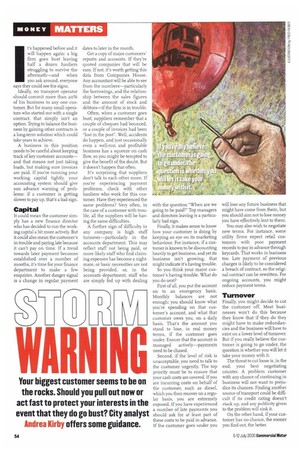VIARNI
Page 56

If you've noticed an error in this article please click here to report it so we can fix it.
Your biggest customer seems to be on the rocks. Should you pull out now or act fast to protect your interests in the event that they do go bust? City analyst Andrea Kirby offers some guidance.
t's happened before and it will happen again: a big firm goes bust leaving half a dozen hauliers struggling to survive the aftermath—and when you ask around, everyone says they could see the signs.
Ideally, no transport operator should commit more than zo% of his business to any one customer. But for many small operators who started out with a single contract, that simply isn't an option. Trying to balance the business by gaining other contracts is a long-term solution which could take years to achieve.
A business in this position needs to be careful about keeping track of key customer accounts— and that means not just taking loads, but making sure invoices are paid. If you're running your working capital tightly, your accounting system should give you advance warning of problems: if a customer is getting slower to pay up, that's a bad sign.
Capital
It could mean the customer simply has a new finance director who has decided to run the working capital a bit more actively. But it could also mean the customer's in trouble and paying late because it can't pay on time. If a trend towards later payment becomes established over a number of months, it's time for your finance department to make a few enquiries. Another danger signal is a change in regular payment dates to later in the month.
Get a copy of major customers' reports and accounts. If they're quoted companies that will be easy. If not, it's worth getting this data from Companies House. Any accountant will be able to see from the numbers—particularly the borrowings, and the relationship between the sales figures and the amount of stock and debtors—if the firm is in trouble.
Often, when a customer goes bust, suppliers remember that a couple of cheques had bounced, or a couple of invoices had been "lost in the post". Well, accidents do happen, and just occasionally even a well-run and profitable business has a squeeze on cash flow, so you might be tempted to give the benefit of the doubt. But it doesn't happen that often.
It's surprising that suppliers don't talk to each other more. If you're experiencing payment problems, check with other hauliers who work for this customer. Have they experienced the same problems? Very often, in the case of a customer with trouble, all the suppliers will be having the same difficulties.
A further sign of difficulty in any company is high staff turnover—particularly in the accounts department. This may reflect staff not being paid, or more likely staff who find claiming expenses has become a nightmare, or basic necessities are not being provided, or, in the accounts department, staff who are simply fed up with dealing with the question "When are we going to be paid?" Top managers and directors leaving is a particu. larly bad sign.
Finally, it makes sense to know how your customer is doing by keeping an eye on its marketing behaviour. For instance, if a customer is known to be discounting heavily to get business, and yet its business isn't growing, that might indicate it's having trouble.
So you think your major customer's having trouble. What do you do next?
First of all, you put the account on to an emergency basis. Monthly balances are not enough; you should know what you're spending on that customer's account, and what that customer owes you, on a daily basis. That's the amount you stand to lose, in real money terms, if the customer goes under. Ensure that the account is managed actively—payments need to be chased.
Second, if the level of risk is unacceptable, you need to talk to the customer urgently. The top priority must be to ensure that your cash costs are covered. If you are incurring costs on behalf of the customer, such as diesel, which you then recover on a regular basis, you are extremely exposed. If you have experienced a number of late payments you should ask for at least part of these costs to be paid in advance. If the customer goes under you will lose any future business that might have come from them, but you should aim not to lose money you have effectively lent to them.
You may also wish to negotiate new terms. For instance, some utility firms expect retail customers with poor payment records to pay in advance through keycards. That works in business too. Late payment of previous charges is likely to be considered a breach of contract, so the original contract can be rewritten. For ongoing accounts, you might reduce payment terms.
Turnover
Finally, you might decide to cut the customer off. Most businesses won't do this because they know that if they do they might have to make redundancies and the business will have to exist on a lower level of turnover. But if you really believe the customer is going to go under, the question is whether you will let it take your money with it.
The threat to cut loose is, in the end, your best negotiating counter. A problem customer with any chance of continuing in business will not want to prejudice its chances. Finding another source of transport could be difficult if its credit rating doesn't stack up, and any publicity given to the problem will sink it.
On the other hand, if your customer has no chance, the sooner you find out, the better.




















































































































